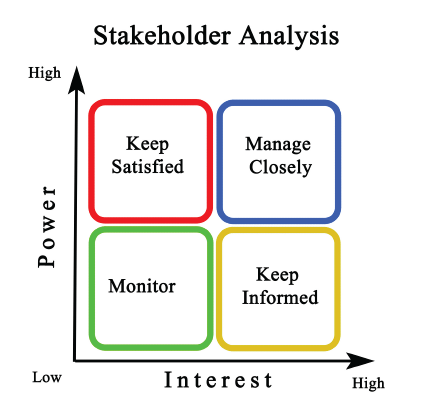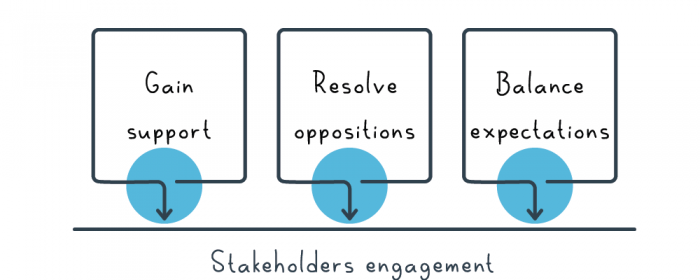Stakeholder engagement is a relatively new term in business. Yes, “Stakeholders” have been there since the dawn of the earliest IPO.
The concepts related to stakeholder analysis and engagement are slowly but surely gaining popularity on the other hand.
We will tell you exactly why.
If you think employees, vendors, customers, shareholders, regulatory/government agencies, even your competitors, play a vital role in a company’s success or failure, you can’t afford to miss a single word of this write-up.
What you will find in this write-up
- What is Stakeholder Engagement?
- The Importance of Stakeholder Engagement
- Norms to Engage Stakeholders?
- Benefits of Stakeholder Engagement
- Stakeholder Engagement FAQ’s
What Is Stakeholder Engagement?
Engaging stakeholders implies that you are involving them in company projects/products.
If we go into a bit of detail, stakeholder engagement is all about interacting with the stakeholders and enabling them to share their ideas, views, agendas, and concerns with you.
The process involves communication, consultation, compromise, and relationship building.
Going by the number of stakeholders, which companies have these days, it looks like a tough task.
And it is.
But, if you put in the effort, its oh-so-worth-it.
If you have any confusion as to which individuals or groups can be stakeholders, we have expert definitions to help you understand the concept:
According to APM Body of Knowledge, 6th edition (2013), stakeholders are:
“Individuals or groups who have an interest in the project, program or portfolio because they are involved in the work or affected by the outcomes”
Whereas, in PRINCE2TM: Glossary of Terms (2009), a stakeholder is defined as:
“Any individual, group or organization that can affect, be affected by, or perceive itself to be affected by, an initiative (program, project, activity, risk)”
The Importance of Stakeholder Engagement

It is unfair to claim the undeniable value stakeholder engagement holds without explaining why is it so.
Here’s why it’s imperative to engage each and every stakeholder:
1. Insights for Strategic Planning
Strategic and development planning is a crucial element for every organization. If done right, it helps the organization have an edge over its competitors.
The more minds you have working on it, the better. Plus, stakeholders give you an outside-the-box perspective which is essential for risk mitigation.
2. Shared Vision
It’s a common occurrence that not everyone in the company relates to its vision. The primary reason behind it is that they don’t know about it. Likewise, there are product visions that are set in place to reflect the grand plan concerning simultaneous products in development.
Moving on, the combined effort of everyone in the workplace is what determines the outcome. Not only the company people, but the stakeholders should be aware of the firm’s vision.
This will allow them to give more accurate feedback which is extremely helpful.
3. Smooth Working
Stakeholders influence the product/service being delivered by the company. As there are many of them, it becomes quite difficult to accommodate every single one of them.
This can be avoided if they are kept in the loop from the beginning. All their concerns can be answered before making the final product.
4. Internal and External stakeholders
Both of them are equally responsible for the way your end product turns out to be.
But many times, companies tend to ignore external stakeholders’ views. This costs them a lot.
External stakeholders hold the key to success. No matter how well-connected you are to the market, having an outside opinion can’t be neglected
5. Future plans
Lastly, every company makes its long-term plans at some point in time. You can’t hope to plan for the long run without having your stakeholders on board.
Stakeholders need to your company to perform better because if you grow, they grow.
Here are Some of the Norms for Stakeholder Engagement…

1. Make Engagement Your Top Priority
Its another way of saying that your whole project should move around engaging stakeholders.
When you have a mindset right from the get-go, everything you do will be centered on how to engage stakeholders in the project process.
When stakeholders are made part of the journey, they connect with the end result better.
The project plan should have a clause to keep stakeholders updated. Moreover, just informing the stakeholders is not enough. You should encourage them to give useful insights and opinions too.
2. Streamline Communication for Smooth Workflow
This is perhaps the most crucial aspect of engaging with stakeholders.
Many times, companies fail to ensure timely and accurate communication with all stakeholders. People just don’t think it’s that important.
Whatever avenues you use to interact with the stakeholders, you have to make sure it’s the best possible way to communicate with them.
Pro tip: Don’t rely on one medium of communication. Have the same message delivered through E-mail, text, and call.
3. Demystify the Type of Engagement You Want
Another highly underrated practice is determining the kind of engagement you want from stakeholders.
The entire project team should be made aware of this beforehand. No one likes to get caught off guard.
Once you have a crystal-clear idea of what you want, it’s time to make the stakeholders understand it.
Better understanding by every party will lead to increased interest.
In return, they will provide the best possible information and ideas.
4. Have them Engage at Every Stage of the Project
Here’s a common misconception: Having stakeholders take only during the production or the selling process is viable; the rest can be managed easily.
It connotes to cutting a fingernail only halfway through. In the worst-case scenario, think of a paper cut! It hurts, right?
We are talking about suppliers, customers, marketing agencies, and what not! They may seem pretty specific in what they do but there’s no harm in involving them at, let’s say, every stage of a project.
Higher engagement of stakeholders will help the company approach new avenues with their product.
5. Develop Relationships
Yes – aim for relationships, not transactions.
The whole point of modern marketing is to build relationships. This is how new-age firms work.
Customized products, a birthday wish, even a thankyou note has more impact on a consumer than any advertisement.
Why else do you think the world felt the need for customer relationship management programs?
Oh, and there are stand-alone software for it now!
6. Have Insights on Reducing Potential Risks
It’s ironic how the most useful aspect is also the most overlooked one.
Your stakeholders come from different backgrounds. Each party has a different take on things.
Let’s say you have an excellent market research team, locally. But you are thinking about making a move overseas.
You don’t know about the area and have no expertise in going international.
But your stakeholders may already know about it.
7. Compromise, Compromise & Comprise
Let’s talk practically; you will never get all stakeholders to agree to your point of view.
There will come times when you just have to find the middle ground. For that, you must talk to the stakeholders.
Remember, you need your stakeholders’ trust and at times, their help as well.
There’s no point in arguing with the people who can influence your work. Take your ego out of the equation.
8. Know What Success Is to Everyone!
It’s very important to understand that success doesn’t mean the same for all.
Completing the project within the deadline may be a great feat for the project team. However, the shareholders will consider awesome sales to be a success in their books.
You have to see things from your stakeholders’ point of view and work around that.
Also, help them understand what success means to you as well. Together, both parties can work to achieve their shared goals.
What are Benefits of Engaging Stakeholders the Right Way?

There is no downside of stakeholder engagement – just the benefits.
Here are some of them:
- The end product is amazing. It’s obvious, isn’t it? When you involve the people, who can influence the end product, you are bound to succeed.
- You open the door to synergies.
- This beautiful concept lets you have unparalleled results. Getting an ‘outside’ opinion about your work is highly beneficial.
- When stakeholders are encouraged to take part in the production or selling process, they like it.
- If you value their feedback, they will take a keen interest in the company affairs and bring more business to you.
- It allows them to voice their opinions. The more you listen to others, the more you learn
- Engaging stakeholders ensure that everyone connected to the firm is on the same page. Did you get a great idea for the company product? Great, get everyone involved and it might turn into an excellent one.
- You can gain something that every company of today desperately searches for – competitive advantage. Without it, you can always be a mediocre player in the market.
- One of the biggest benefits is risk reduction. When you have everyone on board, it leaves little room for any unforeseen circumstance that hasn’t been discussed by all.
- Engagement at this level helps all concerned parties to have a 360° awareness of the organizational practices and circumstances.
- Stakeholder feedback can result in innovation. The type of tech we have today, it’s not difficult to bring life to ideas.
Stakeholder Engagement FAQs
What is stakeholder engagement and why is it important?
It means interacting with the stakeholders and making them participate in the organization’s work. It is important because the more the stakeholders are engaged, the better will understanding they will have of the company and can give useful input.
How do stakeholders get engaged?
By including them in decision making, planning, product/service feedback, and discussing possible ideas for improvement.
How do you build relationships with stakeholders?
You do this by treating them as a part of your organization rather than just business parties. You have to go that ‘extra mile’ to make efforts to interact with them.
What are the benefits of stakeholder engagement?
There are numerous benefits like the pooling of resources, skills, expertise, and ideas for the organization.
What has been included in a stakeholder management plan?
The stakeholder management plan includes the strategies to get stakeholders on board with the firm. It includes all the contacts, media, and communication plans and information regarding stakeholders.
Wrapping It All Up
It’s pretty simple, right? Just a bit of effort and voila! You get better results.
That was all about engaging the stakeholders from our side. If you think we skipped something, feel free to use the comments section below. Alternatively, you can also write to us at fwilson@ntaskmanager.com.

